博文
入侵植物相关指标计算公式
||

By王从彦
入侵植物相对丰度
入侵植物相对丰度(Relative abundance of invasive plants, Pi)计算公式为(Theoharides and Dukes 2007 Theoharides KA, Dukes JS. 2007. Plant invasion across space and time, factors affecting nonindigenous species success during four stages of invasion. New Phytologist 176: 256‒273.; Rai 2015 Rai PK. 2015. Paradigm of plant invasion: multifaceted review on sustainable management. Environmental Monitoring and Assessment 187: 759.; Wang et al. 2021 Wang CY, Cheng HY, Wang S, Wei M, Du DL. 2021. Plant community and the influence of plant taxonomic diversity on community stability and invasibility: A case study based on Solidago canadensis L. Science of the Total Environment 768: 144518.; Wang et al. 2021 Wang CY, Cheng HY, Wu BD, Jiang K, Wang S, Wei M, Du DL. 2021. The functional diversity of native ecosystems increases during the major invasion by the invasive alien species, Conyza canadensis. Ecological Engineering 159: 106093.; Wang et al. 2022 Wang CY, Yu YL, Cheng HY, Du DL. 2022. Which factor contributes most to the invasion resistance of native plant communities under the co-invasion of two invasive plant species? Science of the Total Environment 813: 152628.; Li et al. 2024 Li C, Li Y, Xu ZL, Zhong SS, Cheng HY, Liu J, Yu YL, Wang CY, Du DL. 2024. The effects of co-invasion by three Asteraceae invasive alien species on plant taxonomic and functional diversity in herbaceous ruderal communities in southern Jiangsu, China. Biologia Futura 75: 205–217.):
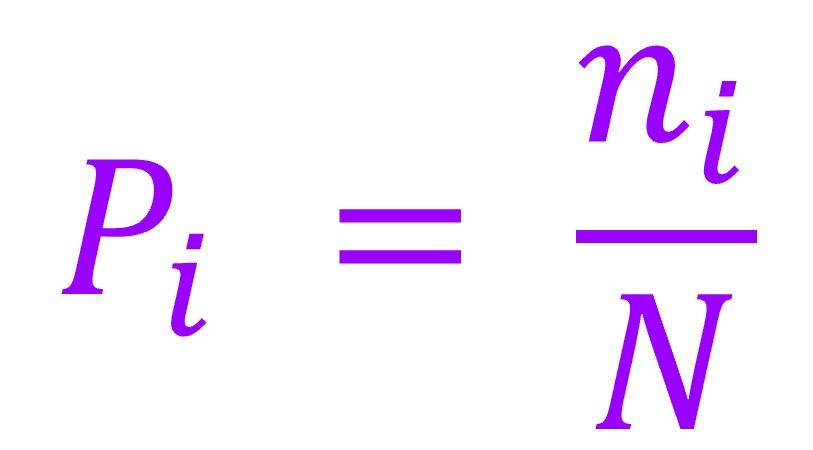
或简化为:
Pi = ni / N
式中ni为调查样方内入侵植物i的植株数量,N为调查样方内所有植物种类的植株数量总数。
入侵植物相对盖度
入侵植物的相对盖度(Relative coverage of invasive plants, RC)按照以下公式计算(Hassan and Mohamed 2020 Hassan MO, Mohamed HY. 2020. Allelopathic interference of the exotic naturalized Paspalum dilatatum Poir. threatens diversity of native plants in urban gardens. Flora 266: 151593.; Li et al. 2021 Li FL, Zhong L, Wen W, Tian TT, Li HC, Cheung SG, Wong YS, Shin PKS, Zhou HC, Tam NFY, Song X. 2021. Do distribution and expansion of exotic invasive Asteraceae plants relate to leaf construction cost in a man-made wetland? Marine Pollution Bulletin 163: 111958.; Guo et al. 2023 Guo X, Li MY, Jiang SY, Yang LY, Guo SX, Xing LJ, Wang T. 2023. Arbuscular mycorrhizal fungi inoculation exerts weak effects on species- and community-level growth traits for invading or native plants under nitrogen deposition. Frontiers in Ecology and Evolution 11: 1152213.):
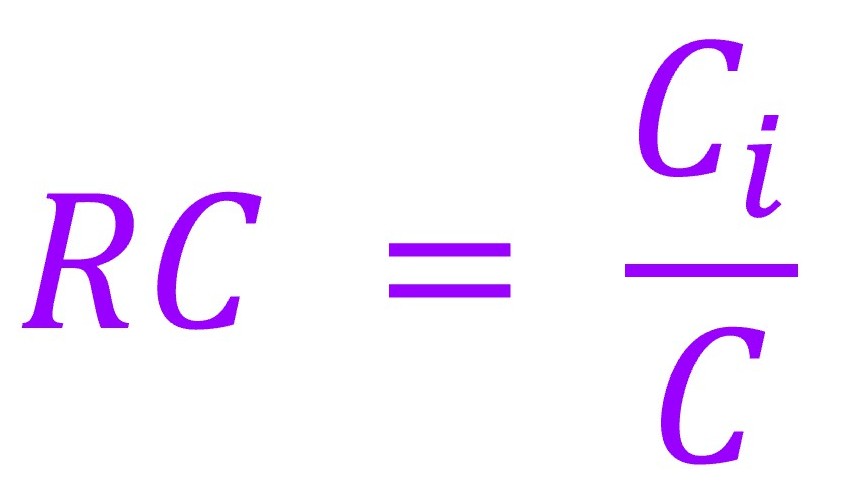
或简化为:
RC = Ci / C
式中Ci为调查样方内入侵植物i的盖度,C为调查样方内所有植物的总盖度。盖度通过植物地上部分的垂直投影面积目测估算。
群落可入侵性指数(Community invasibility index, CII)
群落可入侵性指数(Community invasibility index, CII)计算公式为(Wang CY, Wei M, Wang S, Wu BD, Cheng HY (2020) Erigeron annuus (L.) Pers. and Solidago canadensis L. antagonistically affect community stability and community invasibility under the co-invasion condition. Science of the Total Environment 716: 137128.):
CII = 1 ‒ (MaxPi ‒ Pi)
式中MaxPi为所有调查样方内入侵植物相对丰度最大值,Pi为调查样方内入侵植物的相对丰度。CII值越大表示群落可入侵性越高。
群落可入侵性指数(Community invasibility index, CII)
群落可入侵性指数(Community invasibility index, CII)计算公式为(Guo et al. 2015 Guo Q, Fei S, Dukes JS, Oswalt CM, Iannone III BV, Potter KM. 2015. A unified approach for quantifying invasibility and degree of invasion. Ecology 96: 2613‒2621.; Rijal et al. 2017 Rijal DP, Alm T, Nilsen L, Alsos IG. 2017. Giant invasive Heracleum persicum: Friend or foe of plant diversity? Ecology and Evolution 7: 4936‒4950.):

或简化为:
CII = 1 ‒ (Sobs / Smax + Bobs / Bmax) / 2
式中Sobs和Bobs分别为调查样方内所有植物种类的数量和总生物量。Smax和Bmax分别为所有调查样方内所有植物种类的数量和总生物量最大值。
群落可入侵性指数(Community invasibility index, CII)
群落可入侵性指数(Community invasibility index, CII)计算公式为(Guo et al. 2015 Guo Q, Fei S, Dukes JS, Oswalt CM, Iannone III BV, Potter KM. 2015. A unified approach for quantifying invasibility and degree of invasion. Ecology 96: 2613‒2621.):
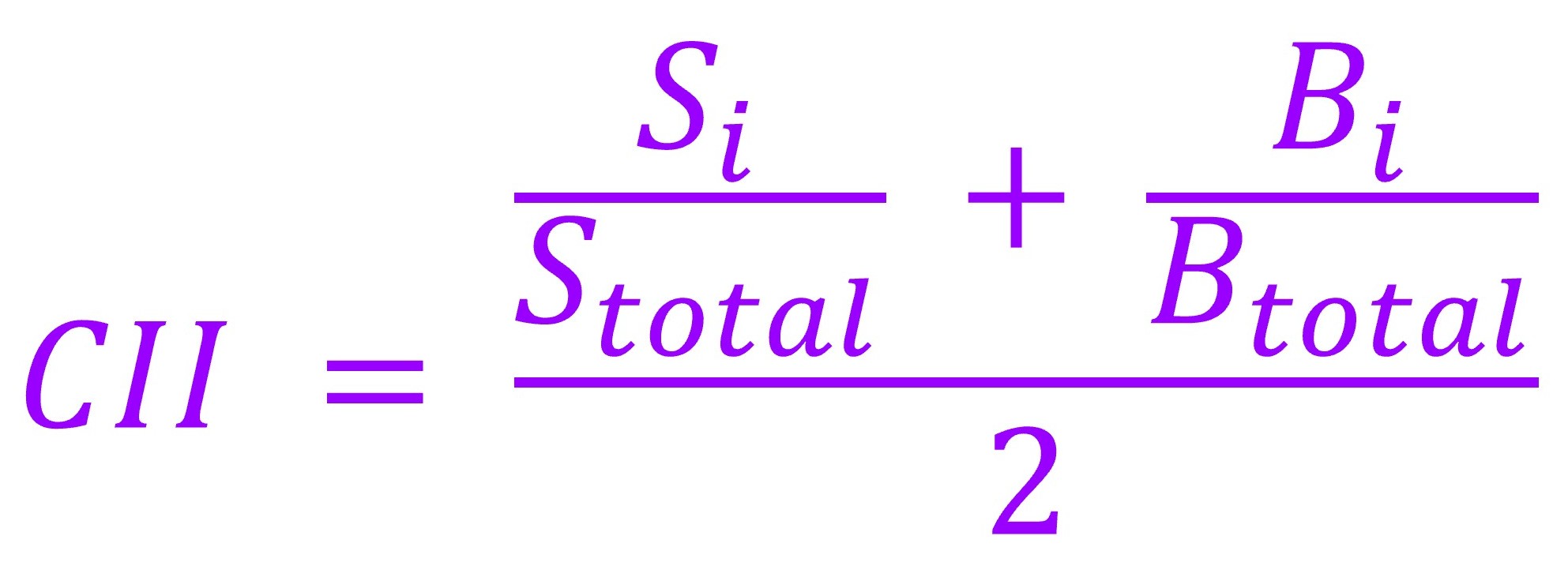
或简化为:
CII = 1 ‒ (Si / Stotal + Bi / Btotal) / 2
式中Si和Bi分别为调查样方内入侵植物的种类数量和总生物量。Stotal和Btotal分别为调查样方内所有物种的种类数量和总生物量。
群落可入侵性指数(Community invasibility index, CII)
The community invasibility (CII) of a plot was calculated as follows (Foster BL, Smith VH, Dickson TL, Hildebrand T. 2002. Invasibility and compositional stability in a grassland community: relationships to diversity and extrinsic factors. Oikos 99: 300–307):
CII = (Si ‒ So) / (S ‒ So)
where So represents the original species number of plants at the beginning of the investigation; Si represents the species number of plants at the time i. S represents the total species number of plants.
植物群落入侵抵抗力指数(Invasion resistance index, IRI)
植物群落入侵抵抗力指数(Invasion resistance index, IRI)计算公式为(Wang CY, Yu YL, Cheng HY, Du DL. 2022. Which factor contributes most to the invasion resistance of native plant communities under the co-invasion of two invasive plant species? Science of the Total Environment 813: 152628.):

或简化为:

或简化为:
IRI = 1 ‒ (ΣPiXi / PnXn)
式中S为调查样方内所有植物种类的数量;Pi为调查样方内入侵植物i的相对丰度,即Pi = ni / N,其中ni为调查样方内入侵植物i的植株数量,N为调查样方内所有植物种类的植株数量总数;Xi为调查样方内入侵植物i的所有测定功能指标(如株高、叶片大小、叶绿素含量、生物量等)的算术平均值;Pn为调查样方内植物n的相对丰度,即Pn = nn / N,其中nn为调查样方内植物n的植株数量,N为调查样方内所有植物种类的植株数量总数;Xn为调查样方内植物n的所有测定功能指标(如株高、叶片大小、叶绿素含量、生物量等)的算术平均值。IRI值越大表示植物群落的入侵抵抗力越大。若调查样方内植物种类均为入侵植物,IRI值为0,表明植物群落入侵抵抗力最低;若调查样方内植物种类无入侵植物,IRI值为1,表明植物群落入侵抵抗力最高。
入侵植物入侵强度指数(Invasion intensity index, III)
入侵植物入侵强度指数(Invasion intensity index, III)计算公式为(Wang CY, Wei M, Wang S, Wu BD, Cheng HY (2020) Erigeron annuus (L.) Pers. and Solidago canadensis L. antagonistically affect community stability and community invasibility under the co-invasion condition. Science of the Total Environment 716: 137128.):

或简化为:
III = Pi / MaxPi
式中MaxPi为所有调查样方内入侵植物相对丰度最大值,Pi为调查样方内入侵植物的相对丰度。III值越大表示入侵植物的入侵强度越高。
入侵植物相对入侵力指数(Relative invasiveness index, RII)
入侵植物相对入侵力指数(Relative invasiveness index, RII)计算公式为(Wang CY, Wei M, Wang S, Wu BD, Cheng HY (2020) Erigeron annuus (L.) Pers. and Solidago canadensis L. antagonistically affect community stability and community invasibility under the co-invasion condition. Science of the Total Environment 716: 137128.):
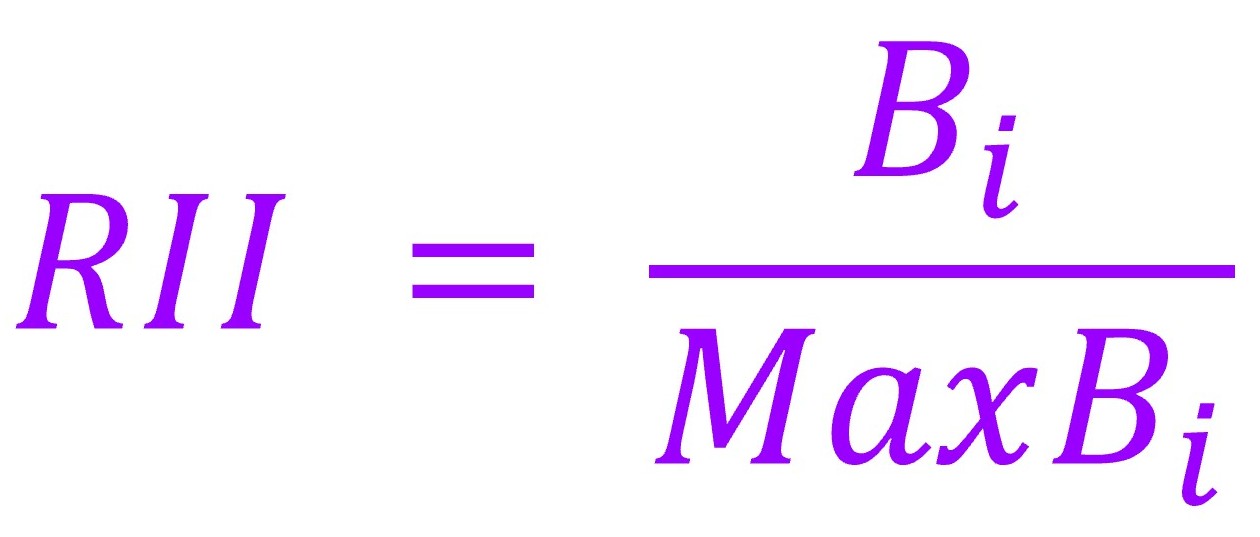
或简化为:
RII = Bi / MaxBi
式中MaxBi为所有调查样方内入侵植物的总生物量最大值,Bi为调查样方内入侵植物的总生物量。RII值越大表示入侵植物的入侵竞争力越高。
入侵植物竞争优势度指数(Competitive advantage index of invasive plant, CAI)
入侵植物竞争优势度指数(Competitive advantage index of invasive plants, CAI)计算公式为(Wang CY, Cheng HY, Wang S, Wei M, Du DL. 2021. Plant community and the influence of plant taxonomic diversity on community stability and invasibility: A case study based on Solidago canadensis L. Science of the Total Environment 768: 144518.):

或简化为:

或简化为:
CAI = Σ(PiXi) / (PaXa)
式中S为调查样方内所有植物种类的数量;Pi为调查样方内入侵植物i的相对丰度,即Pi = ni / N,其中ni为调查样方内入侵植物i的植株数量,N为调查样方内所有植物种类的植株数量总数;Xi为调查样方内入侵植物i的所有测定功能指标(如株高、叶片大小、叶绿素含量、生物量等)的算术平均值;Pa为调查样方内植物a的相对丰度,即Pa = na / N,其中na为调查样方内植物a的植株数量,N为调查样方内所有植物种类的植株数量总数;Xa为调查样方内植物a的所有测定功能指标(如株高、叶片大小、叶绿素含量、生物量等)的算术平均值。CAI值越大表示入侵植物的竞争优势度越大。
共同入侵下不同入侵植物的相对竞争优势度指数(Relative competitive advantage index of invasive plants under co-invasion, RCAI)
共同入侵下不同入侵植物的相对竞争优势度指数(Relative competitive advantage index of invasive plants under co-invasion, RCAI)计算公式为(Wang CY, Li Y, Li C, Zhong SS, Xu ZL, Yu YL, Du DL. 2023. A method for quantifying relative competitive advantage and the combined effect of co-invasion for two invasive plants. Plant Diversity 45: 358‒361.):

或简化为:
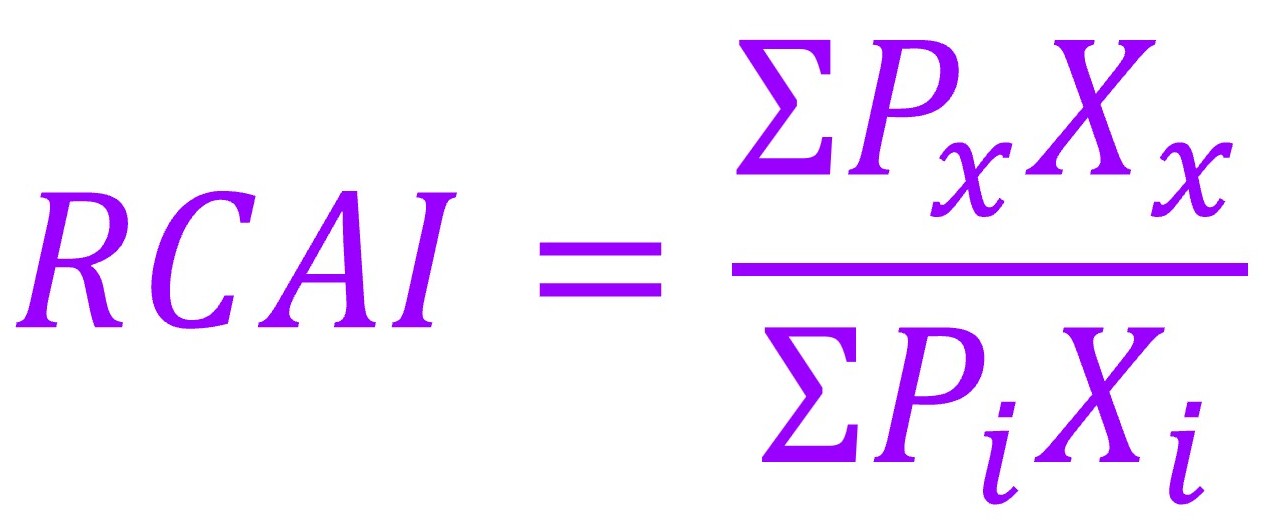
或简化为:
RCAI = Σ(PxXx) / (PiXi)
式中S为调查样方内所有入侵植物种类的数量;Px为调查样方内入侵植物x的相对丰度,即Px = nx / N,其中nx为调查样方内入侵植物x的植株数量,N为调查样方内所有植物种类的植株数量总数;Xx为调查样方内入侵植物x的所有测定功能指标(如株高、叶片大小、叶绿素含量、生物量等)的算术平均值;Pi为调查样方内所有入侵植物相对丰度的总和,即Pi = ni / N,其中ni为调查样方内所有入侵植物的植株数量,N为调查样方内所有植物种类的植株数量总数;Xi为调查样方内所有入侵植物的所有测定功能指标(如株高、叶片大小、叶绿素含量、生物量等)的算术平均值。RCAI值介于0和1之间,且RCAI值越大表示共同入侵下某一入侵植物的竞争优势度越大,反之亦然。
两种入侵植物共同入侵复合效应指数(Co-invasion combined effect index of two invasive plants, CCEI)
两种入侵植物共同入侵复合效应指数(Co-invasion combined effect index of two invasive plants, CCEI)计算公式为(Wang CY, Li Y, Li C, Zhong SS, Xu ZL, Yu YL, Du DL. 2023. A method for quantifying relative competitive advantage and the combined effect of co-invasion for two invasive plants. Plant Diversity 45: 358‒361.):

或简化为:
CCEI = CAIxy / (CAIx + CAIy)
式中CAIxy为两种入侵植物x和y共同入侵状态下的竞争优势度指数(Competitive advantage index of invasive plants, CAI);CAIx和CAIy分别为入侵植物x和入侵植物y单一入侵状态下的竞争优势度指数。若CCEI大于2,表明两种入侵植物共同入侵复合效应为促进;若CCEI等于2,表明两种入侵植物共同入侵复合效应为叠加;若CCEI大于1但小于2,表明两种入侵植物共同入侵复合效应为竞争;若CCEI等于1,表明两种入侵植物共同入侵复合效应为中和;若CCEI大于0但小于1,表明两种入侵植物共同入侵复合效应为拮抗。
入侵植物和本地植物功能差异指数(Functional difference index, FDj)
入侵植物和本地植物功能差异指数(Functional difference index, FDj)计算公式为(Gross et al. 2013 Gross N, Börger L, Duncan RP, Hulme PE. 2013. Functional differences between alien and native species: do biotic interactions determine the functional structure of highly invaded grasslands? Functional Ecology 27: 1262‒1272.):

或简化为:
FDj = (|CWTij ‒ CWTnj|) / (CWTi ‒ CWTn)
式中FDj为样方j内入侵植物特征加权值(CWTij)与本地植物特征加权值(CWTnj)的功能差异指数。CWTi为所有样方或某一处理下所有样方入侵植物特征加权值,CWTn为所有样方或某一处理下所有样方本地植物特征加权值。若FDj大于0表明入侵植物和本地植物功能性状存在明显的差异性,即趋向功能分化(Functionally diverge),生态位分化(Niche differentiation)起主要作用;若FDj小于0表明入侵植物和本地植物功能性状存在明显的相似性,即趋向功能相似(Functionally converge),生境过滤(Habitat filtering)起主要作用。
其中植物特征加权值(Community-Weighted Trait Values, CWT)计算公式为(Violle et al. 2007 Violle C, Navas ML, Vile D, Kazakou E, Fortunel C, Hummel I, Garnier E. 2007. Let the concept of trait be functional! Oikos 116: 882‒892.; Gross et al. 2013 Gross N, Börger L, Duncan RP, Hulme PE. 2013. Functional differences between alien and native species: do biotic interactions determine the functional structure of highly invaded grasslands? Functional Ecology 27: 1262‒1272.):
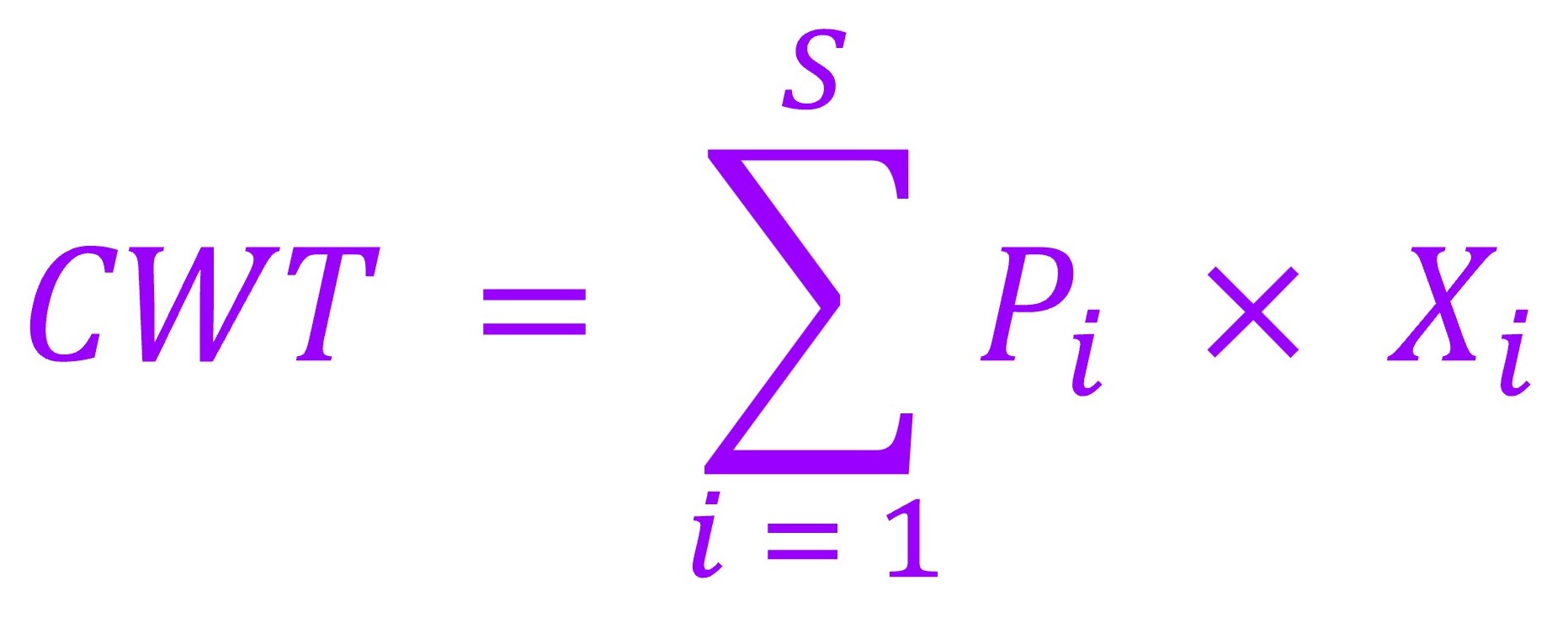
式中S为调查样方内所有植物种类的数量。Pi为调查样方内物种i的相对丰度,即Pi = ni / N,ni为调查样方内物种i的植株数量,N为调查样方内所有植物种类的植株数量总数。Xi为物种i功能指标的平均值。
相对竞争强度指数(Relative competition intensity index, R')
相对竞争强度指数(Relative competition intensity index, R')(含一般植物和入侵植物)计算公式为(Armas et al. 2004 Armas C, Oodiales R, Pugnaire FI (2004) Measuring plant interactions: A new comparative index. Ecology 85: 2682‒2686.; Domènech and Vilà 2008 Domènech R, Vilà M 2008. Response of the invader Cortaderia selloana and two coexisting natives to competition and water stress. Biological Invasions, 10(6), 903–912.; He et al. 2012 He WM, Li JJ, Peng PH (2012) Simulated warming differentially affects the growth and competitive ability of Centaurea maculosa populations from home and introduced ranges. PLoS One 7: e31170.; Gruntman et al. 2014 Gruntman M, Pehl AK, Joshi S, Tielbörger K. 2014. Competitive dominance of the invasive plant Impatiens glandulifera: using competitive effect and response with a vigorous neighbour. Biological Invasions 16: 141‒151.; Li et al. 2015 Li WH, Luo JN, Tian XS, Chow WS, Sun ZY, Zhang TJ, Peng SL, Peng CL. 2015. A new strategy for controlling invasive weeds: Selecting valuable native plants to defeat them. Scientific Reports, 5, 11004–11015.):

或简化为:
R'ij = (Bcoi ‒ Bmi) / (Bcoi + Bmi)
式中R'ij为物种i对物种j的相对竞争强度指数,Bcoi为物种i和物种j混植时单株生物量,Bmi为物种i单植时单株生物量。若R'ij大于0表明物种i的相对竞争强度大于物种j,若R'ij小于0表明物种i的相对竞争强度小于物种j,若R'ij等于0表明物种i的相对竞争强度等于物种j。
相对优势度指数(Relative dominance index, RDI)
相对优势度指数(Relative dominance index, RDI)(含一般植物和入侵植物)按照以下公式计算(Niu et al. 2007 Niu HB, Liu WX, Wan FH, Liu B. 2007. An invasive aster (Ageratina adenophora) invades and dominates forest understories in China: altered soil microbial communities facilitate the invader and inhibit natives. Plant and Soil 294: 73‒85.; Ding et al. 2012 Ding WJ, Wang RQ, Yuan YF, Liang XQ, Liu J. 2012. Effects of nitrogen deposition on growth and relationship of Robinia pseudoacacia and Quercus acutissima seedlings. Dendrobiology 67: 3‒13.; Yuan et al. 2013 Yuan YF, Guo WH, Ding WJ, Du N, Luo YJ, Liu J, Xu F, Wang RQ. 2013. Competitive interaction between the exotic plant Rhus typhina L. and the native tree Quercus acutissima Carr in Northern China under different soil N:P ratios. Plant and Soil 372: 389‒400.):
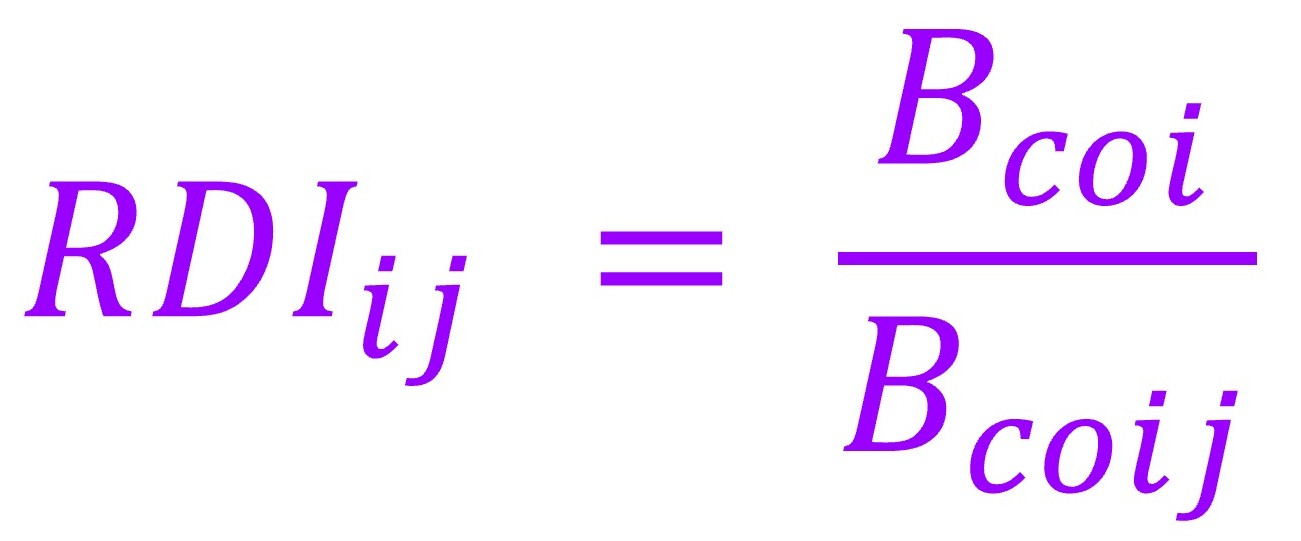
或简化为:
RDIij = Bcoi / Bcoij
式中RDIij为物种i对物种j的相对优势度指数,Bcoij为物种i和物种j混植时两种物种的总生物量,Bcoi为物种i和物种j混植时物种i的生物量。若RDI大于0.5表明物种i的相对竞争力大于物种j,若RDI小于0.5表明物种i的相对竞争力小于物种j,若RDI等于0.5表明物种i的相对竞争力等于物种j。
胁迫抵抗力指数(Stress resistance index, SRI)
胁迫抵抗力指数(Stress resistance index, SRI)(含一般植物和入侵植物)计算公式为(Wang CY, Liu YS, Li C, Li Y, Du DL. 2024. The invasive plant Amaranthus spinosus L. exhibits a stronger resistance to drought than the native plant A. tricolor L. under co-cultivation conditions when treated with light drought. Plants 13: 2251. DOI: 10.3390/plants13162251.):

式中Bs为胁迫处理下的植物总生物量,Bns为无胁迫处理下的植物总生物量。SRI值越大表示植物对胁迫的抵抗力越强。
胁迫强度指数(Stress intensity index, SII)
胁迫强度指数(Stress intensity index, SII)(含一般植物和入侵植物)计算公式为(Tern and Singh 2002 Tern H, Singh SP. 2002. Comparison of sources and lines selected for drought resistance in common bean. Crop Science 42: 64‒70.; Zangi 2005 Zangi M.R. 2005. Correlation between drought resistance indices and cotton yield in stress and non stress conditions. Asian Journal of Plant Sciences 4: 106‒108.; Anwar et al. 2011 Anwar J, Subhani GM, Hussain M, Ahmad J, Hussain M, Munir M. 2011. Drought tolerance indices and their correlation with yield in exotic wheat genotypes. Pakistan Journal of Botany 43: 1527‒1530.; Rao et al. 2013 Rao I, Beebe S, Polania J, Ricaurte J, Cajiao C, Garcia R, Rivera M. 2013. Can tepary bean be a model for improvement of drought resistance in common bean? African Crop Science Journal 21: 265‒281.; Zdravković et al. 2013 Zdravković J, Jovanović Z, Đorđević M, Girek Z, Zdravković M, Stikić R. 2013. Application of stress susceptibility index for drought tolerance screening of tomato populations. Genetika 45: 679‒689.; Ballesta et al. 2020 Ballesta P, Mora F, Pozo AD. 2020. Association mapping of drought tolerance indices in wheat: QTL-rich regions on chromosome 4A. Scientia Agricola, 77: e20180153.):
SII = 1 ‒ (Xs / Xns)
式中Xs为胁迫处理下相关指标的平均值,Xns为对照处理下相关指标的平均值。SII值越大表明胁迫强度越高。
生物量稳定性指数(Biomass stability index, BSI)
生物量稳定性指数(Biomass stability index, BSI)(含一般植物和入侵植物)计算公式为(Anwar et al. 2011 Anwar J, Subhani GM, Hussain M, Ahmad J, Hussain M, Munir M. 2011. Drought tolerance indices and their correlation with yield in exotic wheat genotypes. Pakistan Journal of Botany 43: 1527‒1530.; Farshadfar and Elyasi 2012 Farshadfar E, Elyasi P. 2012. Screening quantitative indicators of drought tolerance in bread wheat (Triticum aestivum L.) landraces. European Journal of Experimental Biology 2: 577‒584.; Farshadfar et al. 2012 Farshadfar E, Jamshidi B, Aghaee M. 2012. Biplot analysis of drought tolerance indicators in bread wheat lanraces of Iran. International Journal of Agriculture and Crop Sciences 4: 226‒233.; Ali and El-Sadek 2016 Ali MB, El-Sadek AN. 2016. Evaluation of drought tolerance indices for wheat (Triticum aestivum L.) under irrigated and rainfed conditions. Communications in Biometry and Crop Science 11: 77‒89.; Darkwa et al. 2016 Darkwa K, Ambachew D, Mohammed H, Asfaw A, Blair MW. 2016. Evaluation of common bean (Phaseolus vulgaris L.) genotypes for drought stress adaptation in Ethiopia. Crop Journal 4: 367‒376.; Sánchez-Reinoso et al. 2020 Sánchez-Reinoso AD, Ligarreto-Moreno GA, Restrepo-Díaz H. 2020. Evaluation of drought indices to identify tolerant genotypes in common bean bush (Phaseolus vulgaris L.). Journal of Integrative Agriculture 19: 99–107.):
BSI = Bs / Bns
式中Bs为植物胁迫处理下植物的生物量,Bns为植物对照处理下植物的生物量。BSI值越大表明植物生物量稳定性越高。
入侵植物对植物物种多样性生态影响风险评估量化方法-入侵植物对植物物种多样性影响幅度指数
1. 入侵植物对植物种类多样性影响幅度指数[The degree of influence index of invasive plants on species diversity (S), DIIS]计算公式为(Wang CY, Cheng HY, Wang S, Wei M, Du DL. 2021. Plant community and the influence of plant taxonomic diversity on community stability and invasibility: A case study based on Solidago canadensis L. Science of the Total Environment 768: 144518.; 王从彦, 杜道林, 黄萍, 孙见凡, 李健, 戴志聪, 李冠霖, 李俊生, 徐海耕, 韦梅, 王舒, 程慧源, 伍丙德, 于友礼. 入侵植物对植物物种多样性生态影响风险评估量化方法(国家发明专利). 申请号: 2020111716877. 申请公布号: CN112308398A. 申请日: 2020/10/28. 申请公布日: 2021/02/02.):
DIIS = 1 ‒ (Si / Sck)
式中Si为入侵植物已入侵样方的植物种类多样性(即:所有植物种类的数量),Sck为入侵植物未入侵样方的植物种类多样性。DIIS值越大表示入侵植物对植物种类多样性的生态影响风险越大。
2. 入侵植物对植物Shannon多样性影响幅度指数[The degree of influence index of invasive plants on Shannon’s diversity (H'), DIIH']计算公式为(Wang CY, Cheng HY, Wang S, Wei M, Du DL. 2021. Plant community and the influence of plant taxonomic diversity on community stability and invasibility: A case study based on Solidago canadensis L. Science of the Total Environment 768: 144518.; 王从彦, 杜道林, 黄萍, 孙见凡, 李健, 戴志聪, 李冠霖, 李俊生, 徐海耕, 韦梅, 王舒, 程慧源, 伍丙德, 于友礼. 入侵植物对植物物种多样性生态影响风险评估量化方法(国家发明专利). 申请号: 2020111716877. 申请公布号: CN112308398A. 申请日: 2020/10/28. 申请公布日: 2021/02/02.):
DIIH' = 1 ‒ (H'i / H'ck)
式中H'i为入侵植物已入侵样方的植物Shannon多样性,H'ck为入侵植物未入侵样方的植物Shannon多样性。DIIH'值越大表示入侵植物对植物Shannon多样性的生态影响风险越大。
其中植物Shannon多样性计算公式为(Shannon CE, Weaver W. 1949. The Mathematical Theory of Communication. University of Illinois Press, Urbana, Illinois, pp. 1‒117.):
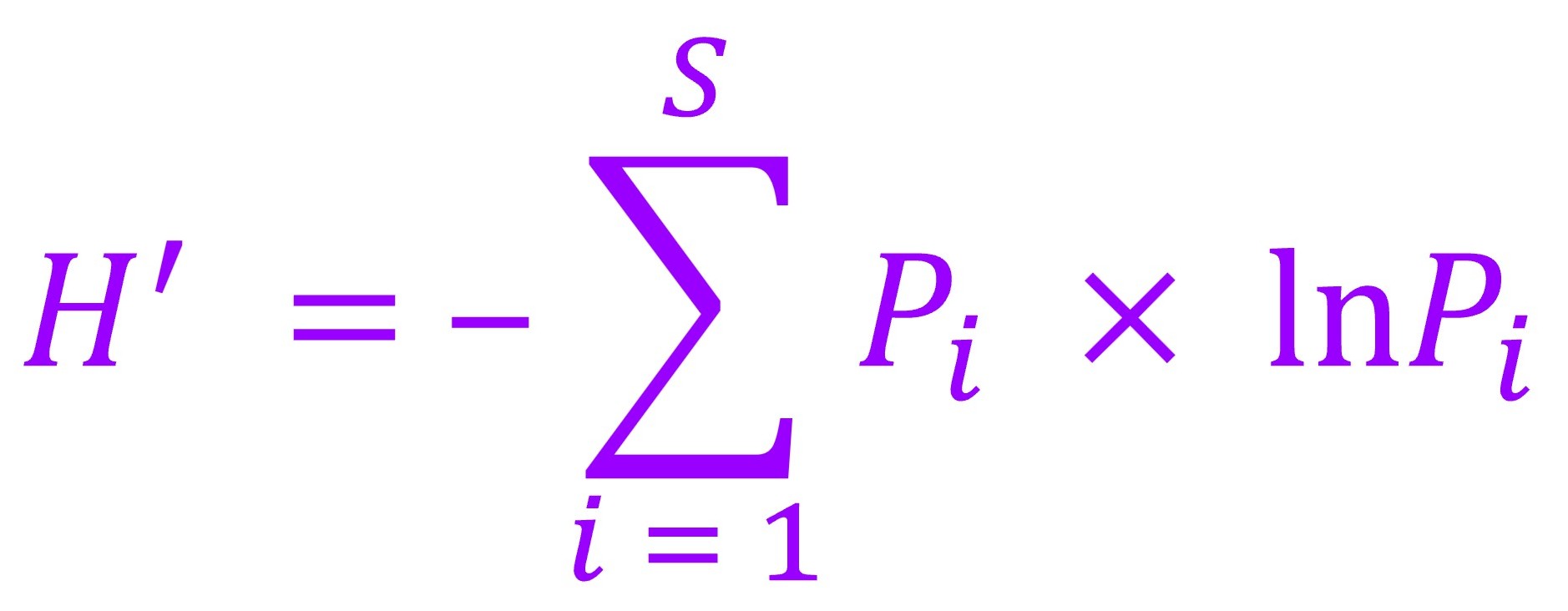
式中S为调查样方的植物种类多样性(即:所有植物种类的数量)。Pi为调查样方内植物i的相对丰度,即Pi = ni / N,其中ni为调查样方内植物i的植株数量,N为调查样方内所有植物种类的植株数量总数。
3. 入侵植物对植物Simpson优势度影响幅度指数[The degree of influence index of invasive plants on Simpson’s dominance (D), DIID]计算公式为(Wang CY, Cheng HY, Wang S, Wei M, Du DL. 2021. Plant community and the influence of plant taxonomic diversity on community stability and invasibility: A case study based on Solidago canadensis L. Science of the Total Environment 768: 144518.; 王从彦, 杜道林, 黄萍, 孙见凡, 李健, 戴志聪, 李冠霖, 李俊生, 徐海耕, 韦梅, 王舒, 程慧源, 伍丙德, 于友礼. 入侵植物对植物物种多样性生态影响风险评估量化方法(国家发明专利). 申请号: 2020111716877. 申请公布号: CN112308398A. 申请日: 2020/10/28. 申请公布日: 2021/02/02.):
DIID = 1 ‒ (Di / Dck)
式中Di为入侵植物已入侵样方的植物Simpson优势度,Dck为入侵植物未入侵样方的植物Simpson优势度。DIID值越大表示入侵植物对植物Simpson优势度的生态影响风险越大。
其中植物Simpson优势度计算公式为(Simpson EH. 1949. Measurement of diversity. Nature 163: 688.):
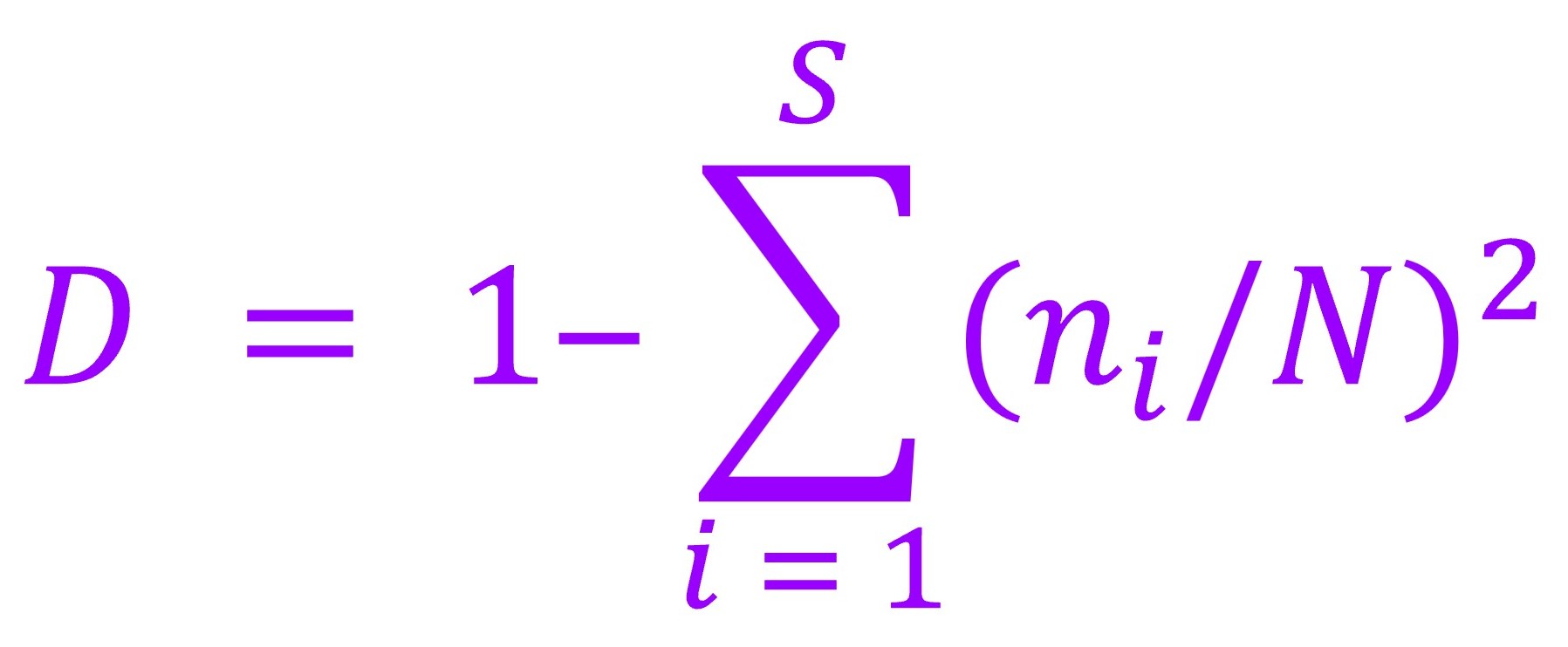
式中S为调查样方的植物种类多样性(即:所有植物种类的数量)。ni为调查样方内植物i的植株数量,N为调查样方内所有植物种类的植株数量总数。
4. 入侵植物对植物Pielou均匀度影响幅度指数[The degree of influence index of invasive plants on Pielou’s evenness (EH), DIIEH]计算公式为(Wang CY, Cheng HY, Wang S, Wei M, Du DL. 2021. Plant community and the influence of plant taxonomic diversity on community stability and invasibility: A case study based on Solidago canadensis L. Science of the Total Environment 768: 144518.; 王从彦, 杜道林, 黄萍, 孙见凡, 李健, 戴志聪, 李冠霖, 李俊生, 徐海耕, 韦梅, 王舒, 程慧源, 伍丙德, 于友礼. 入侵植物对植物物种多样性生态影响风险评估量化方法(国家发明专利). 申请号: 2020111716877. 申请公布号: CN112308398A. 申请日: 2020/10/28. 申请公布日: 2021/02/02.):
DIIEH = 1 ‒ (EHi / EHck)
式中EHi为入侵植物已入侵样方的植物Pielou均匀度,EHck为入侵植物未入侵样方的植物Pielou均匀度。DIIEH值越大表示入侵植物对植物Pielou均匀度的生态影响风险越大。
其中植物Pielou均匀度计算公式为(Pielou EC. 1966. The measurement of diversity in different types of biological collections. Journal of Theoretical Biology 13: 131‒144.):
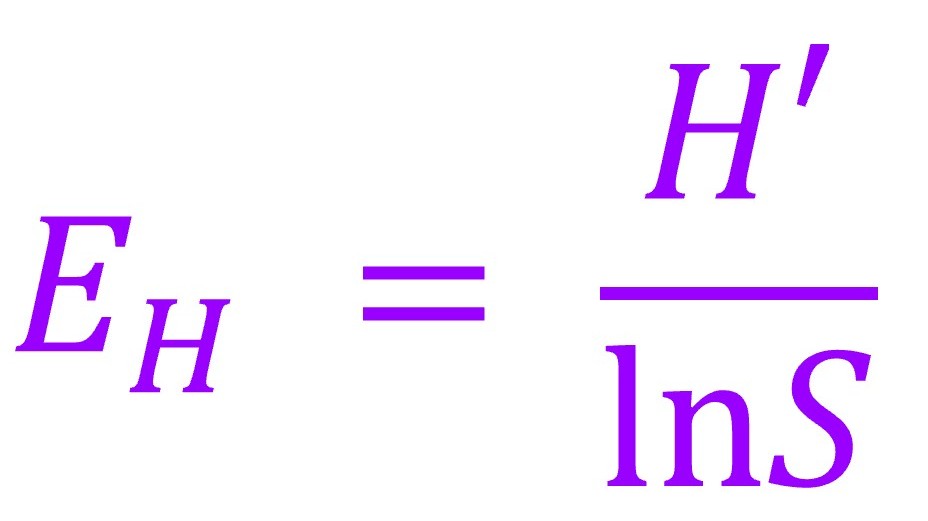
式中H'为调查样方的植物Shannon多样性,S为调查样方的植物种类多样性(即:所有植物种类的数量)。
5. 入侵植物对植物Margalef丰富度影响幅度指数[The degree of influence index of invasive plants on Margalef’s richness (F), DIIF]计算公式为(Wang CY, Cheng HY, Wang S, Wei M, Du DL. 2021. Plant community and the influence of plant taxonomic diversity on community stability and invasibility: A case study based on Solidago canadensis L. Science of the Total Environment 768: 144518.; 王从彦, 杜道林, 黄萍, 孙见凡, 李健, 戴志聪, 李冠霖, 李俊生, 徐海耕, 韦梅, 王舒, 程慧源, 伍丙德, 于友礼. 入侵植物对植物物种多样性生态影响风险评估量化方法(国家发明专利). 申请号: 2020111716877. 申请公布号: CN112308398A. 申请日: 2020/10/28. 申请公布日: 2021/02/02.):
DIIF = 1 ‒ (Fi / Fck)
式中Fi为入侵植物已入侵样方的植物Margalef丰富度,Fck为入侵植物未入侵样方的植物Margalef丰富度。DIIF值越大表示入侵植物对植物Margalef丰富度的生态影响风险越大。
其中植物Margalef丰富度指数计算公式为(Margalef R. 1951. Diversidad de especies en las comunidades naturales (Vol. 6, pp. 59‒72.). Barcelona: Publicaciones del Instituto de Biologia Aplicada.):
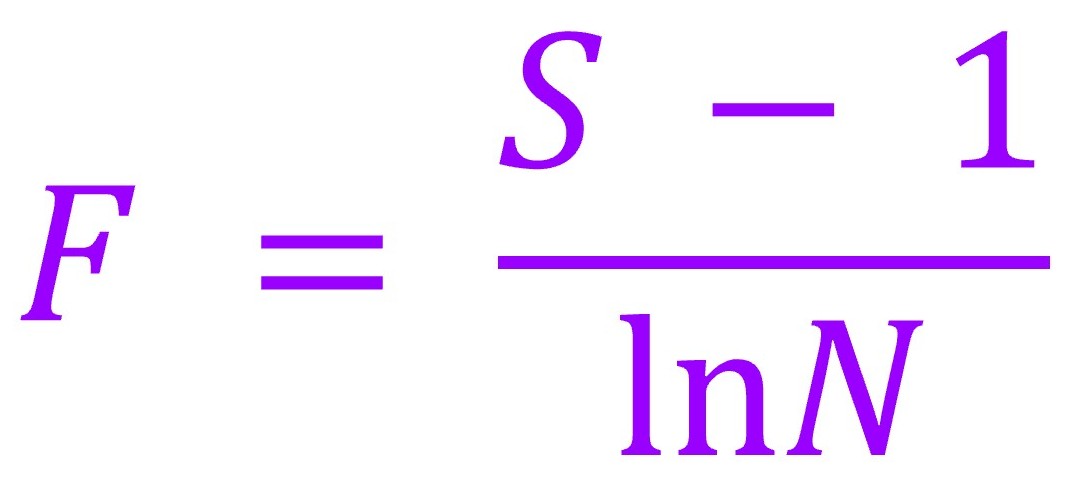
式中S为调查样方的植物种类多样性(即:所有植物种类的数量),N为调查样方内所有植物种类的植株数量总数。
入侵植物直接化感效应和化感遗留效应值
To assess the role of allelopathy in invasive plants in co-cultivation condition, we calculated an index for immediate allelopathy and allelopathic legacy from the competitive responses of invasive plants and native plants. To do this we used log-response ratios, which is defined as the logarithm of the species biomass in the co-cultivation condition relative to the monoculture condition (Hedges et al. 1999 Hedges LV, Gurevitch J, Curtis PS. 1999. The meta-analysis of response ratios in experimental ecology. Ecology 80: 1150–1156.).
In particular, the immediate allelopathy index and allelopathic legacy index were calculated respectively as follows (Del Fabbro and Prati 2015 Del Fabbro C, Prati D. 2015. The relative importance of immediate allelopathy andallelopathic legacy in invasive plants. Basic and Applied Ecology 16: 28–35):
Immediate allelopathy index = (Competitive response in native soil without activated carbon ‒ Competitive response in native soil with activated carbon)
Allelopathic legacy index = (Competitive response in invaded soil without activated carbon ‒ Competitive response in invaded soil with activated carbon) ‒ (Competitive response in native soil without activated carbon ‒ Competitive response in native soil with activated carbon)
植物-土壤反馈系数(Plant-soil feedbacks index, PSF index)
植物-土壤反馈系数(Plant-soil feedbacks index, PSF index)(含一般植物和入侵植物)计算公式为(Van Nuland, M., Bailey, J., Schweitzer, J. 2017. Divergent plant–soil feedbacks could alter future elevation ranges and ecosystem dynamics. Nature Ecology & Evolution 1: 0150.):

或简化为:
PSF index = ln (BLocal / BForeign)
式中BLocal和BForeign分别为植物i在本土土壤下以及在非本土土壤下的生物量。若PSF index大于0,表明植物-土壤反馈为正反馈;若PSF index小于0,表明植物-土壤反馈为负反馈。
注:囿于个人水平有限,错误在所难免。敬请批评指正!
https://blog.sciencenet.cn/blog-565899-1479319.html
上一篇:百般红紫斗芳菲——紫荆
下一篇:桃李芬芳争吐蕊 万紫千红斗春色——李